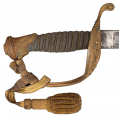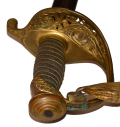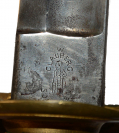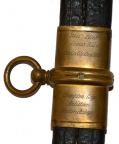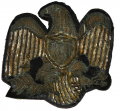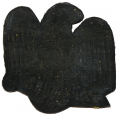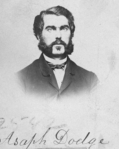site search
online catalog
CASED PRESENTATION SWORD OF LT. ASAPH O. DODGE, 16th NEW YORK, WITH BATTLE HONORS

$9,500.00 ON HOLD
Quantity Available: 1
Item Code: 1052-1134
This officer’s sword not only bears a presentation inscription on the upper scabbard mount and battle honors on the middle mount, it comes with its original gold bullion officer’s sword knot and is housed in its original red lined, wood case with a presentation plaque on its top as well, and containing the officer’s belt, his old first-sergeant’s sash, and a gold embroidered saddle cloth or “shabraque” eagle. The presentation was made after the recipient’s commission as lieutenant and transfer to a new company by members of his old company, with whom he served as Sergeant and First Sergeant. The presentation speeches were recorded in a contemporary newspaper and the recipient was proud enough of it to have it mentioned in his 1919 obituary. The regiment was a two-year unit from New York that saw particularly heavy action at Gaines Mill in the Peninsula Campaign, Crampton’s Gap in the Antietam Campaign, and at Marye’s Heights and Salem Church in the Chancellorsville Campaign.
The sword is a US Model 1850 foot officer’s sword, regulation for company officers of infantry, and on the reverse ricasso is stamped with a standing knight surrounded by “W / CLAUBERG / SOLINGEN,” trademark of that well known German firm supplying swords to American military goods dealers. The sword is the standard configuration with gilt brass hilt, the pommel and openwork guard decorated with floral motifs. The grip typical gray sharkskin wrapped and bound with twisted gilt wire. The hilt shows as an evenly patinaed brass with a couple small spots of verdigris but also some gilt remaining in recessed areas. The detail of the floral elements is very good and the blade pad is in place on the underside of the guard. The grip wrap shows only minor wear, no holes, and the wire is very good. The sword knot is very good as well, showing some age oxidation, but still with good, strong gilt color, with no tears or shredding to the strap and the knot and tassels fully intact.
The blade is the standard configuration- slightly curved and single-edged, has a good edge and point, and is etched on the spine “IRON PROOF” and with two brightly etched panels on the blade placed midway along the fuller, both with foliate terminals. The obverse panel shows an eagle with outstretched wings perched on a long, leafy branch, with an “E PLURIBUS UNUM” ribbon scroll underneath. The reverse has a large “U.S.” in contoured, shaded letters. There is some slight oxidation and age staining to the blade lower down, below the etching, but the overall impression is bright metal with frosting evident in the ground of the etched panels.
The scabbard is the regulation black leather with gilt brass mounts. The leather shows impressed border lines front and back, with a center seam on the reverse. The leather is solid, but showing unevenness to the finish and small wear spots and losses, but good overall color. The mounts are in place, with the drag a bit loose. The upper and middle mounts have ring bands cast and chased on the obverse with floral motifs and are engraved with geometric foliate motifs at each end. The drag is engraved with a long, similar geometric foliate motif somewhat rococo in style, though symmetrical, with the drag blade cast with raised, curving foliate scrolls. The reverse of the mounts was left plain and the upper mounts were engraved there for the presentation. The upper mount reads: “Presented to/Lieut. A.O. Dodge/by Co F/16th Regt. N.Y. Vol./Feb. 1863.” We note a small gap was left between the month and year to fill in the exact date of the presentation, which has been left blank. The middle mount was engraved with battle honors: “West Point/ Gaines Hill/ Charles City Cross Roads” above the ring band, and “Crampton Gap/ Antietam/ Fredericksburg” below the ring band. The wood case in which the sword is housed in a form fitted “French-style” recess also bears an inscription engraved on a gilt brass plaque applied to the inset escutcheon on the top reading: Lt. A Dodge / Co. E 16th NYSV / Presented by Co. F.”
The 16th New York, known also as the First St. Lawrence County Regiment and the First Northern New York Regiment, was officially organized at Albany, received its numerical designation May 9, 1861, and was mustered into US service on May 15. In keeping with New York’s practice at the time, the term of service was two years, with later recruits signing up for three years and transferring to the 121st NY when the unit mustered out. Dodge had enrolled at age 22 at Potsdam, NY, on April 27 and mustered in as a sergeant in Company F when the unit joined the US service. He was promoted to First Sergeant, the senior NCO of the company, at a date not stated in the records, and was commissioned an Ensign, i.e.: 2nd Lieutenant, on June 25, 1862, and assigned to Company E. His commission was dated December 8, 1862, and gave him rank from June 27. He must have performed well, being promoted to First Lieutenant, also in Company E, January 21, 1863, with his commission dated February 24, granting him rank from January 21. From the date of the presentation, it seems the sword was given in honor of this second promotion and indicates his popularity among his former comrades, and maybe some local pride: Company F had been recruited in Potsdam, but Company E was from Plattsburg.
A contemporary newspaper article records not only the presentation, but the speech of Private Sylvester Abbot on behalf of the company and Dodge’s response. Abbot spoke as follows: “Lieutenant Dodge - Company F takes this opportunity of presenting you with an evidence that the faithful service rendered, and generous deeds performed by you have not passed unnoticed by them. For this end a committee was appointed to present this Sword, as a mark of their esteem for you, as a soldier and friend. The devoted attachment you have shown in always sustaining the interests of the Company, has drawn forth the admiration of its every member. You will therefore accept this, as a token of our undivided regards. Take it (handing him the Sword) and as you wield it in defense of your Country, may the God of Battles nerve you on to victory.”
Dodge responded in kind: “Soldiers of Co. E – This is wholly unexpected: How can I express my gratitude. I had felt in my heart that I had been double paid for all I had ever done while laboring with you. If I have done ought worthy of your appreciation, I am more than satisfied. When I was ordered away from you it was with great reluctance I obeyed. I turned my back to my old comrades for a new field of labor. You who were first to offer yourselves on the altar of your Country, you who have never flinched before the galling fire of the enemy, you who have endured the long and toilsome marches under a scorching Southern sun without a murmur - to you l am indebted for this beautiful Sword, and while wielding it in the cause of freedom and that old Star Spangled Banner, I trust no act of mine will cause the least regret in the hearts of its donors. May a just God guard and protect you and return you safe to your homes and friends. Permit me to tender my sincere thanks and remember in me you will always find a friend.”
The regiment had drilled and trained for a time in New York before leaving the state for Washington, via NY City and Baltimore, on June 27, 1861. It suffered a few men wounded at Fairfax Court House in the run-up to Bull Run, but just one officer wounded in that engagement, and saw some further action at Pohick Church in September and October 1861. In May 1862 it became part of the 6th Corps and saw heavy action in McClellan’s Peninsula campaign, losing 6 killed and 11 wounded at West Point on May 7, took part in the fighting near Mechanicsville and the Chickahominy, and in the Seven Days Battles, including at Gaines Mill on June 27 (called “Gaines Hill” in the inscription,) where they lost 58 officers and men in killed and mortally wound alone and another 173 wounded who recovered to some degree. At Garnett’s and Golding’s Farm and at Malvern Hill they escaped without casualties according to Phisterer, but at Glendale, between those two fights, they lost another 11 in killed, wounded, and missing. (A short 1886 regimental history distributes the losses a little differently, and adds 54 men as missing at Gaines Mill, which it, too, refers to as Gaines Hill.)
During the Antietam Campaign they took part in the 6th Corps assault on Confederate positions at Crampton’s Gap on September 14, suffering 26 officers and men killed or mortally wounded and another 37 who recovered, in heavy fighting that drove Confederates from the mountain, opening up the rear of Confederates besieging Harpers Ferry to attack, though neither McClellan or the corps commander followed up the advantage. (The regimental history claims losses of 32 killed and 90 wounded at Crampton’s Gap, in being the first to reach the summit, capture of one Confederate flag, and taking more prisoners than the regiment had men in the ranks.) On the field of Antietam itself they were deployed late in the fighting near Dunker Church on the line under fire of sharpshooters until nightfall on September 18, losing 3 men wounded according to Phisterer and an additional 2 dead according to the regimental history.
At Fredericksburg in December 1862, they were deployed on picket duty on the left of the line and suffered no direct battle casualties, though the regimental asserts 36 men died over the following six weeks from exposure on that duty. In the Chancellorsville Campaign, after Dodge received the sword, they were among the Union troops that stormed Marye’s Heights and fought at Salem Church in the effort to relieve pressure on Hooker or strike Lee in the rear, losing yet another 154 officers and men in killed, wounded, and missing according to Phisterer and 168 according to the regimental.
The regiment returned to Albany for muster out on May 22, 1863. The three-year men had been transferred to the 121st NY and some records, include Dodge among them, likely because his commission would have included a revised enlistment date, but the officers were likely redundant to that regiment and his muster out is officially dated May 22 as well. Dodge had been born in Searsport, Maine in 1838, but by 1855 was living in Grafton, Worcester County, MA, with his parents and siblings- there had been twelve in all, most surviving to adulthood. By 1860 they were in Canton, Lawrence County, NY, where, like his father and one brother, Dodge worked as a shingle maker. He seems to have returned there after muster out, but was married in Baltimore in October 1865, living in Worcester County again in 1870, with his wife and 4 month-old daughter, working in a boot and shoe factory, and by 1880 was in Baltimore with his family, working as a cutter of sole leather. By 1886, however, they were in Washington, D.C., where he had obtained a position in the Adjutant General’s office, where he seems to have worked until resigning in 1918. He was active in the G.A.R., being a member of the George Meade Post No. 5 and serving as Post Commander in 1899. He died in 1919 and was interred at Arlington.
The sword is accompanied by a bullion embroidered shabraque eagle that may have made its way into his possessions later since as an infantry line officer he would not be mounted. The sword belt with it retains the short forward sling with snap hook and carrying hook, but is missing the longer rear sling. A small illegible maker or retailer stamp is on the safe. The buckle is a regulation M1851 rectangular sword belt plate, but is the late war enlisted pattern and we note the belt not only has just a simple brass stud for adjustment, but a rather simple brass wire keeper, suggesting another plate was on it- so the belt, like the shabraque eagle may be from his G.A.R. days or even membership in a fraternal or masonic organization (we note he was a member also of the United Order of the Golden Cross) and the plate a yet later addition. Interestingly though, the sash with it, in fair condition, with tears and holes, but good color, knots and tassels, is the red worsted wool sash of a First Sergeant, likely a survivor from Dodge’s earlier service at that rank, though it is tempting to think his old comrades may have included it instead of a silk officer’s sash as a reminder not to forget his origins.
This is a strong sword with a good history in fine condition that displays impressively. [sr][ph:L]
~~~~~~~~~~~~~~~~~~~~~~~~~~~~~~~~~~~
THIS ITEM, AS WITH ALL OTHER ITEMS AVAILABLE ON OUR WEB SITE,
MAY BE PURCHASED THROUGH OUR LAYAWAY PROGRAM.
CLICK HERE FOR OUR POLICIES AND TERMS.
THANK YOU!
Inquire About CASED PRESENTATION SWORD OF LT. ASAPH O. DODGE, 16th NEW YORK, WITH BATTLE HONORS
For inquiries, please email us at [email protected]
Most Popular
Historical Firearms Stolen From The National Civil War Museum In Harrisburg, Pa »
Theft From Gravesite Of Gen. John Reynolds »
Selection Of Unframed Prints By Don Troiani »
Fine Condition Brass Infantry Bugle Insignia »
Wonderful Condition Original Confederate-Manufactured Kepi For A Drummer Boy Or Child »
featured item
VERY ATTRACTIVE DOUBLE CASED SIXTH-PLATE AMBROTYPES OF CIVILIAN AND CONFEDERATE SOLDIER IN A RARE UNION CASE
The relationship between the two men pictured is not known but no doubt they are either brothers or the same man at different points in his life. The left side ambrotype is of a seated man sporting a closely trimmed beard and mustache wearing a dark… (1138-1975). Learn More »
site search
Upcoming Events
The shop will remain closed to the public through Friday, Jan. 31st, re-opening on Saturday, Feb.… Learn More »








